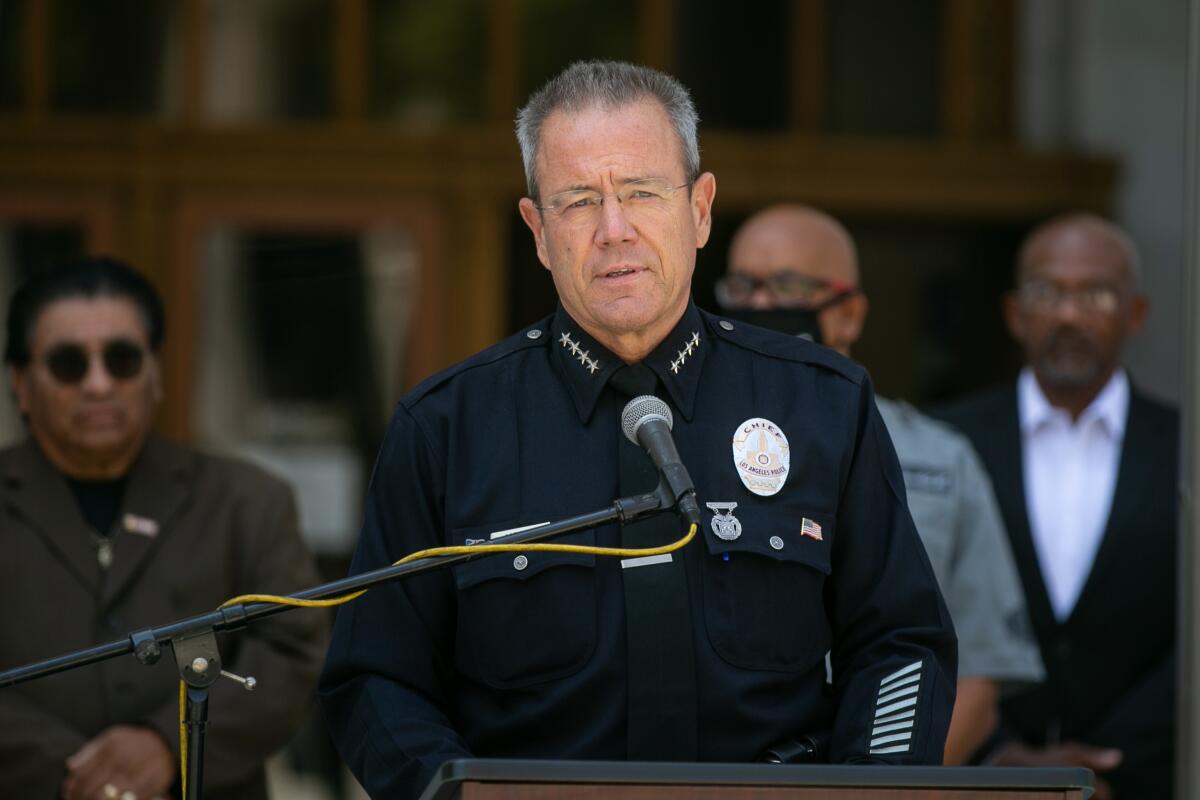After release of officer photos, emails show LAPD union leaned on chief to act

- Share via
The day after an activist group published the photos and names of thousands of Los Angeles police officers in March, a top police union official emailed LAPD Chief Michel Moore and warned that the department’s initial response was not strong enough for the rank and file’s liking.
Jerretta Sandoz, vice president of the Los Angeles Police Protective League, wrote Moore to say that although the publication of the officer photos hadn’t broken any laws according to the union’s legal team, it nevertheless “caused extreme concern.”
“Silence only flames the already lit fire,” Sandoz wrote in the March 18 email to Moore, which was obtained by The Times through a public records request. “This situation is important and poses safety concerns for officers and their families. I saw you on the news but that footage doesn’t get it 90% of officers. Please let us know how the Department plans to move forward related to this. If we can help in anyway let us know.”
Less than two weeks later, the Protective League changed its tune.
On March 27, the union, which represents most of the city’s officers, sued Moore. Its attorneys argued that LAPD brass had refused to take appropriate action to prevent further disclosure of undercover officers’ photos, which were provided to the Stop LAPD Spying Coalition and published on a website called WatchtheWatchers.net. The union sought a temporary restraining order to prevent what it described as further harm to its members.
LAPD union sues the chief to prompt him to get undercover officer photos off the web, and wants the activist website Watching the Watchers taken down until the city determines which images should be excluded
The disclosure spawned several other legal challenges. The city sued the Stop LAPD Spying Coalition and Knock LA journalist Ben Camacho, who obtained the more than 9,300 images last September through a public records request and related litigation. Camacho subsequently filed a motion asking a judge to dismiss the city’s suit on the grounds that it was unconstitutional and retaliatory.
In the weeks after the photos’ release, more than 300 LAPD officers who claimed to work in sensitive assignments also gave notice that they intend to sue the city for negligence and for allegedly endangering their lives. That number has since climbed to more than 600, city records show.
City Atty. Hydee Feldstein Soto began lobbying California lawmakers to weaken the state’s public records law to allow government agencies to decline similar records requests in the future.
Camacho and Stop LAPD Spying have argued that the department was using the controversy as cover to become less transparent.
Camacho posted communications with city officials prior to the photos’ release in which they said the disclosure did not include any undercover officers. But after the photos were published, Moore and other officials began to suggest in news interviews that some undercover officers were accidentally included, which posed a potential risk to their safety. Moore later told The Times that he had taken steps to address the safety concerns, and said he didn’t become aware of the photos until after their publication.
The city’s attempt to claw back the images was roundly denounced as legally meritless by constitutional and media-rights experts, and a coalition of media organizations including The Times filed a legal motion asking the court to reject the city’s efforts.
But earlier this month, a judge unexpectedly ruled that the city can justifiably censor the free speech of the activist group by forcing it to stop publishing pictures of LAPD officers online. Attorneys for Stop LAPD Spying and Camacho said they plan to appeal the judge’s ruling on the grounds that “prior restraint” on the speech of a political group is allowed only under “extraordinary” circumstances.
A California judge said the city of Los Angeles could justifiably force an activist group to stop publishing pictures of LAPD officers online.
Inside the department, the photos release set off a scramble to assign blame.
On the morning of March 18, when the controversy was still in its infancy, Moore held a conference call with his command staff “to discuss the recent release of photos of Department personnel,” according to an email obtained by The Times. Among those copied on the email setting up the call were Liz Rhodes, the civilian director of the Office of Constitutional Policing, and Julie Raffish, an assistant city attorney who is intimately involved in department matters. After some technical difficulties, the meeting was switched over to the Microsoft Teams app.
It’s not clear precisely what was discussed or what plans were made.
In a response to an email inquiry from The Times, Moore said that when he “learned of the release of photos of our people and that it inadvertently included individuals working confidential and sensitive assignments, I was similarly concerned as were many of our people.”
Moore wrote that he ordered an investigation into “how the release occurred and who was involved.”
“Additionally, I communicated with our command officers and as I recall issued a message from our Department Operations Center to our personnel expressing my concerns and what steps we were taking,” Moore said.
A message seeking comment from Sandoz was not immediately returned early Friday afternoon.
A couple of hours after Moore’s March 18 command staff meeting, Sandoz emailed Moore, copying the union’s board of directors and its general counsel, Robert Rico. The subject line read, “Photo/info leak debacle.”
“Although our legal team found that the release of the photos isn’t illegal, it’s caused extreme concern to the rank and file, especially officers who work in an undercover capacity,” Sandoz wrote in the email. “The LAPPL has been fielding calls since the site has been up and running. Our concern is that the Department has been silent on this very important issue and has not communicated to officers anything about this situation.”
Sandoz continued: “We are fielding calls from not only the undercover officers, but seemingly everyone. There are even some of your Captains having officers call the lappl.”
She pointed out that the department sends out “many” messages to officers on a daily basis and that “it’s our hopes that the Department communicates to the rank and file what has happened, what can be done if anything, what’s next for undercover officers, etc.”
While it’s not uncommon for union officials and LAPD brass to communicate about department operations and officer concerns, a source familiar with LAPD affairs who is not authorized to speak publicly said more serious matters are typically followed up in writing in a formal letter from the union.
After several delays in responding to a records request from The Times, the city provided certain communications about the photo release but withheld others that it maintained were exempt from disclosure. The city also denied previous records requests for correspondence between Moore and Rhodes and between the chief and Raffish, the assistant city attorney.
In a departmentwide email, LAPD Chief Michel Moore included a list of sensitive positions and asked other officers to self-identify if they wished to remain anonymous.
In response to a similar request by Times, the Los Angeles city attorney’s office said it “was able to identify responsive records” regarding Raffish, but they were protected by attorney-client privilege.
Mayor Karen Bass called the release “an unacceptable breach that put the lives of our officers and their families at risk,” and said she expects a “full accounting” of how it happened. The LAPD’s investigation is ongoing.
More to Read
Sign up for Essential California
The most important California stories and recommendations in your inbox every morning.
You may occasionally receive promotional content from the Los Angeles Times.















